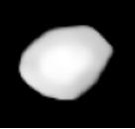Astronomy:24 Themis
 | |
| Discovery | |
|---|---|
| Discovered by | Annibale de Gasparis |
| Discovery date | 5 April 1853 |
| Designations | |
| (24) Themis | |
| Pronunciation | /ˈθiːmɪs/[1] |
| Named after | Themis |
| 1947 BA; 1955 OH | |
| Minor planet category | Main belt (Themis) |
| Adjectives | Themistian[2] /θɪˈmɪstiən/[3] |
| Orbital characteristics[4] | |
| Epoch 23 July 2010 (JD 2455400.5) | |
| |{{{apsis}}}|helion}} | 529.4 Gm (3.539 AU) |
| |{{{apsis}}}|helion}} | 406.8 Gm (2.719 AU) |
| 468.1 Gm (3.129 AU) | |
| Eccentricity | 0.1310 |
| Orbital period | 2021 d (5.54 yr) |
| Mean anomaly | 146.6° |
| Inclination | 0.7595° |
| Longitude of ascending node | 35.99° |
| 107.7° | |
| Physical characteristics | |
| Dimensions | c/a = 0.76±0.08[5] |
| Mean diameter | 208±3 km[5] 198±20 km[6] |
| Mass | (6.2±2.9)×1018 kg[5] (11.3±4.3)×1018 kg[6] 2.3×1019 kg[7][8] |
| Mean density | 1.31±0.62 g/cm3[5] 2.78±1.35 g/cm3[6] |
Equatorial surface gravity | 0.15+0.08 −0.07 m/s2[6] |
Equatorial escape velocity | 87+15 −20 m/s[6] |
| Rotation period | 0.34892 d (8 h 23 min)[4] |
| Geometric albedo | 0.060 (calculated)[5] 0.067[4] |
| C/B[4] (B-V=0.68) | |
| Absolute magnitude (H) | 7.08[4] |
Themis (minor planet designation: 24 Themis) is one of the largest asteroids in the asteroid belt. It is also the largest member of the Themistian family. It was discovered by Annibale de Gasparis on 5 April 1853. It is named after Themis, the personification of natural law and divine order in Greek mythology.
Not to be confused with 269 Justitia, named for Justitia, Themis' Roman name.
Discovery and observations
24 Themis was discovered on 5 April 1853 by Annibale de Gasparis of Naples, though it was given its name by fellow Italian astronomer Angelo Secchi. The asteroid was named after Themis, the Greek goddess of law.[9] Gravitational perturbations in the orbit of Themis were used to calculate the mass of Jupiter as early as 1875.[10]
On 24 December 1975, 24 Themis had a close encounter with 2296 Kugultinov with a minimum distance of 0.016 AU (2.4×106 km). By analyzing the perturbation of Kugultinov's orbit due to the gravitational pull of Themis, the mass of Themis was determined to be approximately 2.89×10−11 solar masses[11] (9.62×10−6 Earth masses).
Orbit and rotation
Themis is in an elliptical orbit around the Sun with an eccentricity of 0.1306 and an inclination of 0.76°.[12] It has an orbital period of 5.54 years. The distance between Themis and the Sun ranges from 2.71 AU at perihelion and 3.55 AU at aphelion,[13] with a mean distance of 3.1302 AU.[12] Themis is part of the Themis family of asteroids, which is located in the outer part of the main belt. The family consists of a core of large objects surrounded by a cloud of smaller objects; 24 Themis is a member of the core.[13]
Surface materials
Ice
On 7 October 2009, the presence of water ice was confirmed on the surface of this asteroid using NASA’s Infrared Telescope Facility.[14]Cite error: Closing </ref> missing for <ref> tag in the form of tholins, high-molecular weight organics found in the outer solar system, distinguished by a brown or reddish color in optical spectra. Compounds found in the spectra of Themis include ice tholin (the residual of an irradiated mixture of water ice and ethane), asphaltite, carbonaceous meteorite material, and polycyclic aromatic hydrocarbons.[15][16]
See also
Water presence on other celestial bodies:
References
- ↑ Noah Webster (1884) A Practical Dictionary of the English Language
- ↑ Astronomy now, Volume 22 (2008)
- ↑ Themistian (3rd ed.), Oxford University Press, September 2005, http://oed.com/search?searchType=dictionary&q=Themistian (Subscription or UK public library membership required.)
- ↑ 4.0 4.1 4.2 4.3 4.4 "JPL Small-Body Database Browser: 24 Themis". 17 March 2010. http://ssd.jpl.nasa.gov/sbdb.cgi?sstr=Themis.
- ↑ 5.0 5.1 5.2 5.3 5.4 P. Vernazza et al. (2021) VLT/SPHERE imaging survey of the largest main-belt asteroids: Final results and synthesis. Astronomy & Astrophysics 54, A56
- ↑ 6.0 6.1 6.2 6.3 6.4 Baer, James; Steven R. Chesley (25 June 1999). "Astrometric masses of 21 asteroids, and an integrated asteroid ephemeris". Celest. Mech. Dyn. Astron. (Springer Science+Business Media B.V. 2007) 100 (2008): 27–42. doi:10.1007/s10569-007-9103-8. Bibcode: 2008CeMDA.100...27B.
- ↑ Michalak, G. (2001). "Determination of asteroid masses". Astronomy & Astrophysics 374 (2): 703–711. doi:10.1051/0004-6361:20010731. Bibcode: 2001A&A...374..703M.
- ↑ (Mass of Themis 0.12 / Mass of Ceres 4.75) × Mass of Ceres 9.43×1020 = 2.38×1019
- ↑ Schmadel, Lutz D. (2003). Dictionary of minor planet names (5th ed.). Springer. p. 17. ISBN 978-3-540-00238-3. https://books.google.com/books?id=KWrB1jPCa8AC&q=dictionary+of+astronomy+themis&pg=PA17.
- ↑ "Our Astronomical Column". Nature 13 (316): 48. 18 November 1875. doi:10.1038/013047d0. Bibcode: 1875Natur..13...47.. https://www.nature.com/nature/journal/v13/n316/pdf/013047d0.pdf?foxtrotcallback=true.
- ↑ García, A. López; Medvedev, Yu. D.; Fernández, J. A. Moraño (1997). "Using Close Encounters of Minor Planets for the Improvement of their Masses". Poznań, Poland: Kluwer Academic Publishers. pp. 199–204. ISBN 978-0-7923-4574-9. https://books.google.com/books?id=sJe_2VBDYNEC&q=Using+close+encounters+of+minor+planets+for+the+improvement+of+their+masses.&pg=PA199.
- ↑ 12.0 12.1 The Astronomical Almanac. United States Naval Observatory and United Kingdom Hydrographic Office. 2011. p. G2. ISBN 978-0-7077-4103-1.
- ↑ 13.0 13.1 "Dictionary of Astronomy". Oxford Dictionary of Astronomy. Oxford University Press. 27 May 2010. pp. 528.
- ↑ Cowen, Ron (8 October 2009). "Ice confirmed on an asteroid". Science News. http://www.sciencenews.org/view/generic/id/48174/title/Ice_confirmed_on_an_asteroid. Retrieved 9 October 2009.
- ↑ Cite error: Invalid
<ref>tag; no text was provided for refs namedRivkin2010 - ↑ Emery, Joshua P.. "Advances in Solar System Science: Research Enabled by 2.4 – 25 μm Spectroscopy with SOFIA". https://www.sofia.usra.edu/sites/default/files/Poster_5.10_Emery.pdf.
External links
- Asteroid Themis has 'frosted surface'
- NASA detection of Water Ice and organics on the surface of 24 Themis
- 24 Themis at AstDyS-2, Asteroids—Dynamic Site
- 24 Themis at the JPL Small-Body Database
 |

